
Dryland dog sledding and dryland
dog sledding requires it's own special
terms and jargon.
Bar brake or claw brake
This is a piece of aluminum with metal
spikes that dig into the snow that the
musher steps on to hold the sled in place
once the sled is stopped.
Basket
This is the portion of the dog sled in
front of the musher where passengers sit
or where gear is carried.
Bridle
Similar to the rigging on a sail boat.
It is a series of lines and bungees that
run from the rear of the basket to the
front of the sled and are used to connect
the lines. A carabineer is then connected
between the bridle and the shock absorber
(if one is being used) which is then connected
to the gang line.
Brush bow
The brush bow is a piece of curved wood,
metal or plastic in front of the basket.
It is designed to absorb impact during
crashes similar to a bumper on a vehicle.
Bungee or Shock Absorber
These devices are inserted between the
rig or the dog sled and the gang line
to relieve stress on the dogs and absorb
jolts during starting and stopping. Smaller
lines designed for one to three dogs are
used for skijoring, bikejoring and scootering
may include a shock absorber built directly
into the line.
Dog boxes
Made of fiberglass, metal or wood these
boxes are mounted on the bed portion of
a flat bed or pick up truck and are used
to transport sled dogs.
Dog sled
Maryland Sled Dog Adventures LLC uses
MaineMade dog sleds which designed for mid-distance, stage, and long distance mushing. Similar to skis, dog sleds are
steered by flexing them. Dog sleds come
in many different varieties including,
basket sleds and toboggan sleds. Basket
sleds ride on runners on top of the snow
about four to six inches off the snow.
Toboggan sleds ride directly on the snow.
Toboggan sleds usually work better in
deep, untracked snow. Basket sleds work
better on packed trails and in general
are a little easier to steer through sharp
corners. Dog sleds are also categorized
by how they are used for racing including,
sprint sleds, mid distance sleds and distance
sleds. Typically, the longer the race,
the larger the sled because most mid-distance
and distance races require the musher
to carry certain required equipment (e.g.,
snowshoes, an axe, a sleeping bag rated
to a certain temperature, booties for
each dog, and dog food).
Dog Truck
This is a truck used for transporting
dogs. With large teams of dogs, the truck
is usually a large pick up or flat bed
truck with dog boxes built on the bed.
Smaller, micro mushing kennels, may use
different vehicles including, SUVs, mini
vans, full size vans, or station wagons.
Drag or drag brake
This is a piece of snowmobile track that
rests between the runners of the dog sled
right under the driver's feet. To slow
the sled, the musher steps down onto the
drag.
Driving bow
This is the handle bar of the sled which
the musher holds onto while driving the
sled.
Drop lines, Drop Chains or Picket
lines
These are cable (or chain) lines used
to tether dogs at a trail head, race or
event while waiting to go out for a run.
Gang line
This is the main line which is connected
to the rig or the dog sled. A gang line
is made up of three distinct components:
The main (center) line, neck tugs, and
tug lines. The dogs are then connected
to the center line by a neck line which
connects to each dog's collar and by a
tug line which connects to the tug loop
on each dog's harness. The dogs pull by
pulling on the tug line not the neck line.
The neck line merely keeps the dogs alongside
the main line and the leaders side by
side.
Handler
The musher's chief assistant. A handler
helps harness/unharness dogs, hook dogs
up to the line, hydrate dogs, train dogs,
feed dogs, load and unload dogs and equipment
from the truck, repairs equipment, drives
the dog truck from check point to check
point in long races, and generally helps
the musher out. At races, a handler might
help the musher get his or her dogs to
the starting line. A good handler doesn't
get paid much but is worth his or her
weight in gold.
Leaders or lead dogs
These are some of the most special dogs
on a dog team. They are the dogs that
know best the commands that the musher
gives and are responsible for following
those commands. They are also in the dogs
that set the pace. As they say in mushing:
"If you aren't the lead dog, the view
never changes."
Musher
Also known as a dog driver and chief poop
scooper. The musher drives the sled or
rig, trains the dogs, cares for the dogs,
assists by pedaling or running up hills,
and scoops the dog yard.
Point dogs
These dogs run right behind the leaders.
Sled Bag
This is a heavy bag which is tied to the
basket of the dog sled and holds gear.
It can also be used to hold a dog injured
on the trail or too tired to continue
that needs a lift back to the trail head.
Race rules usually require that these
bags be vented (i.e., have a mesh window)
so that a dog being carried in the bag
does not over heat.
Snow hook
This resembles a small but sharp boat
anchor and serves much the same purpose.
It is connected to the sled by a line,
and is deployed (set) when the musher
needs to hold the sled in place and get
off the sled. The musher sets his snow
hook by putting it on the snow and digging
it in with his foot while allowing the
dogs to pull forward to "set" the hook.
Snub line
This line is used to hold the sled or
rig in place on the trail or while hooking
the dogs up or unhooking dogs. It is frequently
paired with a quick release, panic snap
or wooden pin so that it can be quickly
released by the musher at take off while
standing on the dog sled or the rig.
Swing dogs
These dogs run right in front of the wheel
dogs.
Team dogs
All other dogs between the point dogs
and the swing dogs.
Wheel dogs or wheelers
These are the dogs that are hooked in
closest to the dog sled or the rig. They
tend to be large powerful dogs. They usually
have the most impact in pulling the sled
or rig through turns. |
|
|
|
|
Our dogs are a part of our family and are as much
sled pets as working dogs.
We started dog sledding with our first two dogs because we were looking for a way to exercise
them.
Our sled pets are family. They live their entire
lives with us including their retirement years.
Today, dog sledding and dryland mushing are things
that we do to spend time with our dogs. It's not about
getting them to pull you, it's about enjoying the
precious time that you have with them.
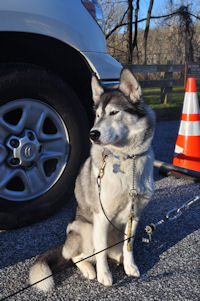 |
Kiana's Vale CGC, RN, SD is a very accomplished ten year old female Siberian Husky. As with Beaver and Acadia, Vale is from Kiana
Siberians, a Siberian husky breeder in New
Hampshire that specializes in multipurpose Siberian
Huskies. Vale (pedigree) is an amazing command trained lead dog. Vale can frequently be spotted leading the team down the trail. Vale had puppies fall of 2016l and both Vale and her puppy, Casco, have returned home. |
| Ebony is a seven year old female Siberian Husky from Bray Hill Siberians in Phillips, Maine.
Ebony (pedigree) is one of the shyer dogs on the team, but can run in any position. We are training Ebony to lead our teams. While she is small, she is quite mighty. Ebony is developing into quite a nice little leader. Keep an eye out for the little "nose nibbler" leading our teams this winter.
|

|
 |
Nisha is a seven year old Siberian Husky from Bray Hill Siberians in Phillips, Maine. Nisha (pedigree) is a sensitive, but skilled sled dog and runs in the lead through wheel positions on the team. Nisha is Ebony's sister. We continued to be amazed with Nisha's performance in harness. Look for Nisha to be excitedly leading our teams down the trail! |
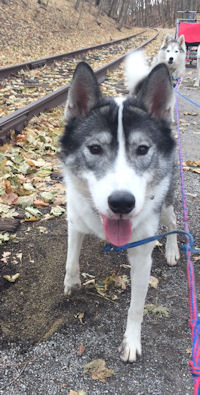 |
Kiana's Casco Bay ("Casco") (pedigree) is one of our best lead dogs. Casco is from the breeding of our dog, Kiana's Vale, with an established long distance sled dog Sibersong's Super Trouper. Casco is almost four years old. Casco, along with Drogo, give the team a solid foundation for the future. |
|
Fort Illio's Zoom is one of Maryland Sled Dog Adventures LLC's newest sled dogs! Zoom (pedigree) comes to us from Maine's Fort Illio Kennels. Zoom started training this winter. |

|
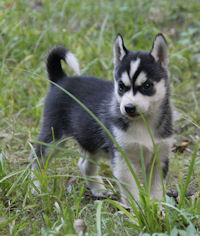 |
Kelim's Yara (pedigree) is the newest sled dog to join Maryland Sled Dog Adventures LLC. Yara started training in the Spring. |
Visiting Sled Dogs
From time to time, Maryland Sled Dog Adventures, LLC, hosts visiting sled dogs from other kennels. These dogs get the opportunity to run with our team and socialize with lots of kids.
 |
Kiana's Mopar Muscle RN (aka Charger) was a red and white siberian husky and more importantly, Sammamish's litter mate. Charger now lives in Massachusetts with several other siberian husky friends, but was with Maryland Sled Dog
Adventures LLC for the 2012 - 2013 season. Charger absolutely adored being around PEOPLE! Little ones, big ones, and all sorts in between were Charger's favorites. Charger ran anywhere and everywhere he could in the team. |
Retired Sled Dogs
Maryland Sled Dog Adventures LLC loves it's active and retired sled dogs. Our retired dogs live a pampered life.
| Kiana's Leave it to Beaver SDO RN (aka Beaver) is an awesome and very experienced thirteen year old Siberian Husky who became a permanent part of Maryland Sled Dog Adventures LLC after the 2012- 2013 season. Beaver's SDO title is the highest recognition a sled dog can receive for achievement in running or racing from the Siberian Husky Club of America. Beaver (pedigree) is very versatile and can run anywhere including in lead. If you aren't petting Beaver enough, he'll gently remind you to pet him. Beaver's last run was May 9, 2020. He retired after almost 14 years in harness! |
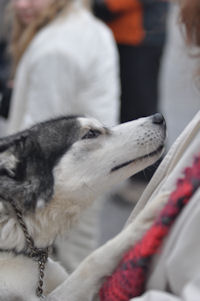
|
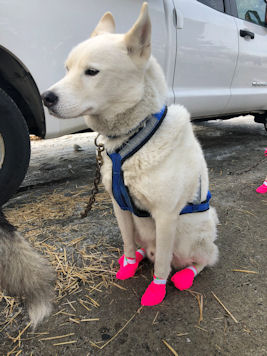 |
Kelim's Lumos is an twelve year old male Siberian Husky. Lumos joined Maryland Sled Dog Adventures LLC from Fort Illio kennels in Lexington, Maine in December 2014. Lumos was bred by Kelim Siberians in New Hampshire. Lumos has experience running on 30 mile, 60 mile, and 250 mile race teams. Lumos is a super awesome tank dog whose tug is always tight. Lumos (pedigree) primarily runs in the point, swing, and wheel positions with Maryland Sled Dog Adventures LLC. Lumos loves food! Lumos retired midway through the 2019-2020 season when he began to show lameness in his hind end. Lumos is looking forward to his full retirement benefits including meals twice a day and a midday snack. |
|
North Wapiti's Flare visited Maryland Sled Dog Adventures LLC from her home kennel, Bray Hill Siberians, in Phillips, Maine for several years before retiring with us. Flare was bred by Iditarod musher Karen Ramstead at North Wapiti Kennels and has an awesome pedigree. Her litter's webpage is available. Flare's mother (Hilda, Iditarod finisher) and father (Draco, 5 time Iditarod finisher) were both strong long distance racing sled dogs. Flare ran any and every position on the team and was a good, reliable leader. Flare retired at the beginning of the 2018 season. |
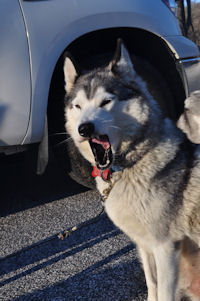 |
Gone, But Not Forgotten
Maryland Sled Dog Adventures, LLC, has been very fortunate with most of our dogs surviving well into advanced age in good health.
| Kiana's Sammamish (aka Sammi)(8/23/2010 - 10/06/2014) was an amazing dog in harness, around the house, and as our friend. Sammi was from Kiana
Siberians in Sanbornton, NH. Sammi was an AKC registered, red and white, blue
eyed Siberian Husky. His sire was CH Alkasiber's
Tres Pete and his dam was CAN
CH Kiana's Khocolate Kiss, CGC, TT, WPD, WLD,
RA, SDO ("Valeska"). Sammi ran in all positions on the team (lead, team, and wheel) and was part of our Can-Am 30 team in 2014. At four years old, Sammi was our next generation leader and we miss him tremendously. Sammi was a major hit with the kids and was one of the most tolerant dogs we've seen. He thrived on all of the attention he received at our programs. Sammi became sick and we worked with our local vet until additional resources were needed. Sammi was treated at the University of Pennsylvania Ryan Veterinary Hospital, but emergency surgery was unsuccessful. |
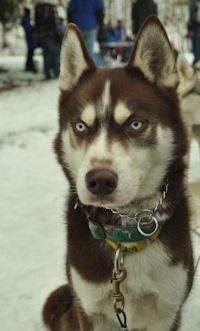
|
|
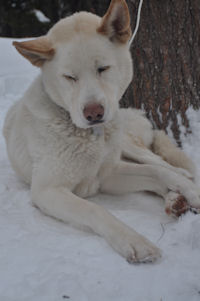
|
Okemo (aka Okimer,
Keemie) (12/17/2005 - 11/4/2015) was our big Siberian Husky - Akita mix. Okemo came
to us via the big silver stork (Delta airlines)
from a rescue in Tennessee. Okemo was
a bit of a tank and almost always ran in the wheel
position. Okemo loved to have his nose rubbed,
had the softest ears, and absolutely loved food. Okemo was
a big, blue eyed hugga head. Okemo retired from the team in February 2015 after tearing his ACL during a run in icy conditions. Okemo died very suddenly in the prime of his retirement in November 2015. |
|
Gypsy visited Maryland Sled Dog Adventures LLC from her home kennel in Pennsylvania for the the 2010 - 2011 and 2011 - 2012 dog sledding seasons. Gypsy ran in the lead and team positions at Maryland Sled Dog Adventures LLC. Gypsy returned home and enjoyed retirement before passing away in April 2016. |
 |
 |
Luke was Gypsy's kennel mate and joined Maryland Sled Dog Adventures LLC for the the 2010 - 2011 and 2011 - 2012 dog sledding seasons. Luke had incredible drive and would run all day long. Luke ran in Katahdin Iron Works race with the Maryland Sled Dog Adventures team and was an active participant in the women's Maine Winter Cabin Adventure program. Luke returned home and enjoyed retirement before passing away in December 2015. |
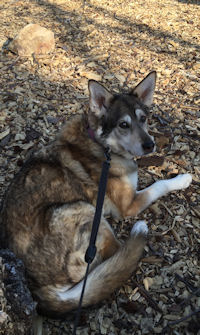 |
Zoë (12/25/2000 - 6/20/2018) was the entire reason we got into dog sledding: to find her an outlet for her energy. She took to it well and we soon had not just a hobby, but a lifestyle. Zoë became one of the best lead dogs we've ever had as we embarked on the mushing life. Zoë retired at around ten years of age as arthritis in her back began to bother her. She was seventeen and a half years old when she passed, having lived a good life. |
|
T-Bone (aka Mr.
Bone) (3/2/2002 -7/12/2018) was our Siberian / Sheltie mix. T-Bone came to us from Tails
of the Tundra Siberian Husky Rescue, Inc.
T-Bone had an injured hip when we got him as a puppy. T-Bone was initially not such a big fan of running, but loved to wear the harness. One day, he decided to run and suddenly we had a team. T-Bone retired relatively early as issues with his hip crept up. T-Bone dealt with Old Dog Vestibular syndrome, bouts of colitis, and a host of neurological issues as he aged. T-Bone was sixteen and a half when he passed. |

|
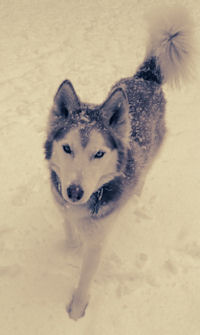 |
Sobo (aka Mr.
Buboo and Sobolicious 12/6/2004-4/17/2020) was our sixteen and a half year old
Siberian Husky. Sobo originally came from Frederick
County Animal Control as a four month old Siberian
puppy with "too much energy." Sobo
was a rescue dog that we were fostering for Tails
of the Tundra Siberian Husky Rescue, Inc.
Because he was a such a good fit with Zoë
and T-Bone, we failed Fostering 101 and decided
to make him a permanent family member. Sobo retired after the Katahdin Iron Works 30 race in Brownville, ME in 2014 being a mainstay on the team for many years. Sobo's favorite activities in retirement were lounging around the yard and sleeping in the bedroom in 'his' dormer. |
|
|